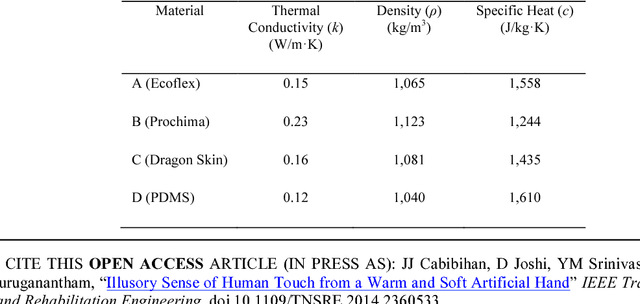Mark Aaron Chan
Illusory Sense of Human Touch from a Warm and Soft Artificial Hand
Feb 27, 2015

Abstract:To touch and be touched are vital to human development, well being, and relationships. However, to those who have lost their arms and hands due to accident or war, touching becomes a serious concern that often leads to psychosocial issues and social stigma. In this paper, we demonstrate that the touch from a warm and soft rubber hand can be perceived by another person as if the touch were coming from a human hand. We describe a three step process toward this goal. First, we made participants select artificial skin samples according to their preferred warmth and softness characteristics. At room temperature, the preferred warmth was found to be 28.4 deg C at the skin surface of a soft silicone rubber material that has a Shore durometer value of 30 at the OO scale. Second, we developed a process to create a rubber hand replica of a human hand. To compare the skin softness of a human hand and artificial hands, a robotic indenter was employed to produce a softness map by recording the displacement data when constant indentation force of 1 N was applied to 780 data points on the palmar side of the hand. Results showed that an artificial hand with skeletal structure is as soft as a human hand. Lastly, the participants arms were touched with human and artificial hands, but they were prevented to see the hand that touched them. Receiver operating characteristic curve analysis suggests that a warm and soft artificial hand can create an illusion that the touch is from a human hand. These findings open the possibilities for prosthetic and robotic hands that are lifelike and are more socially acceptable.
 Add to Chrome
Add to Chrome Add to Firefox
Add to Firefox Add to Edge
Add to Edge